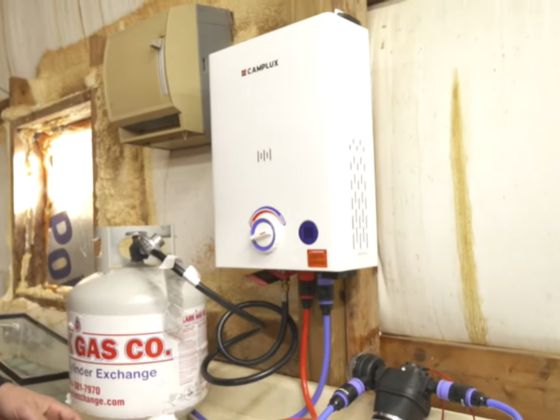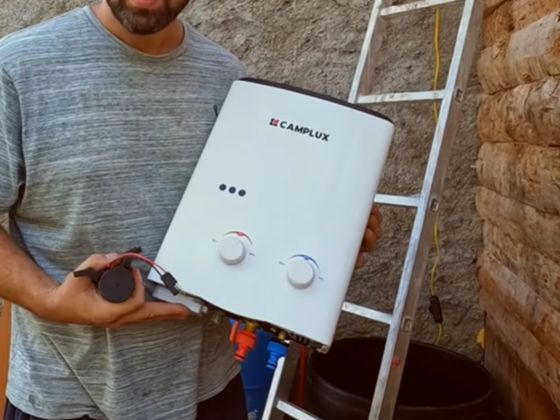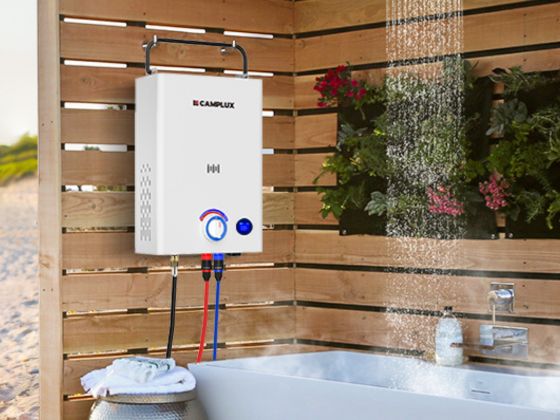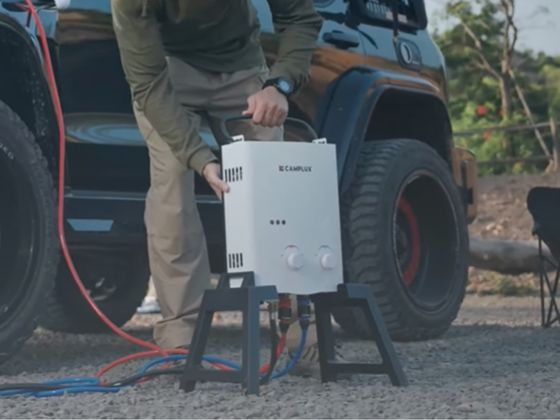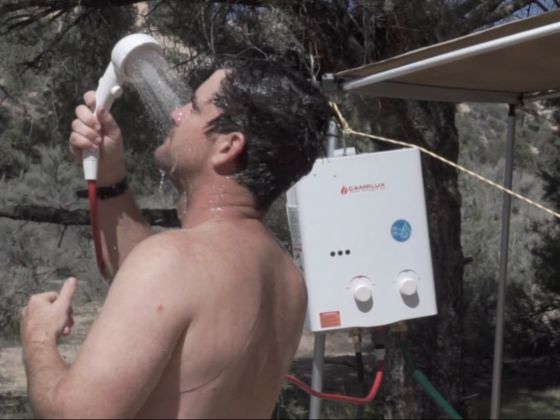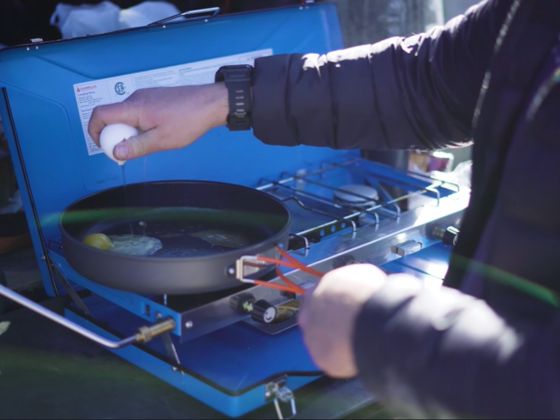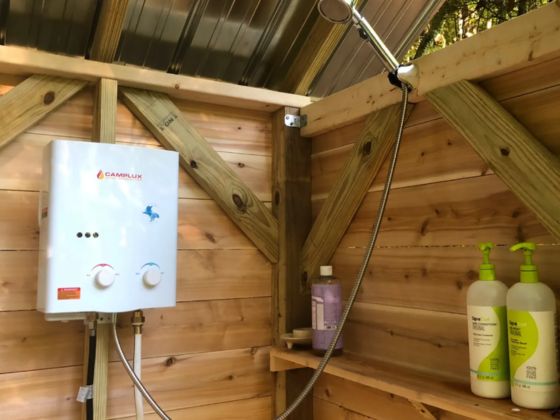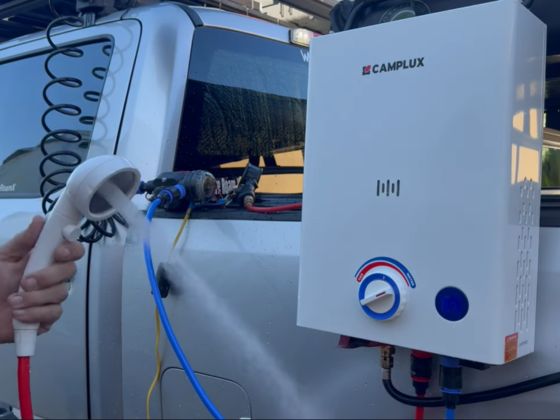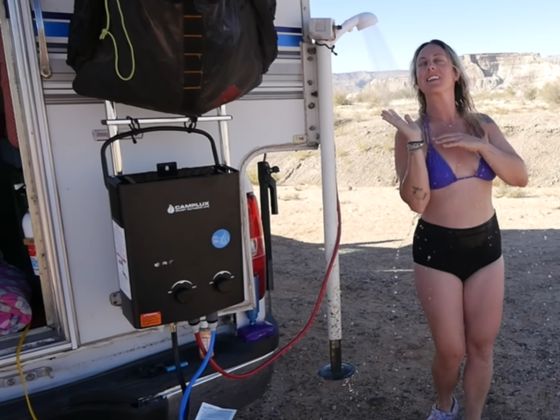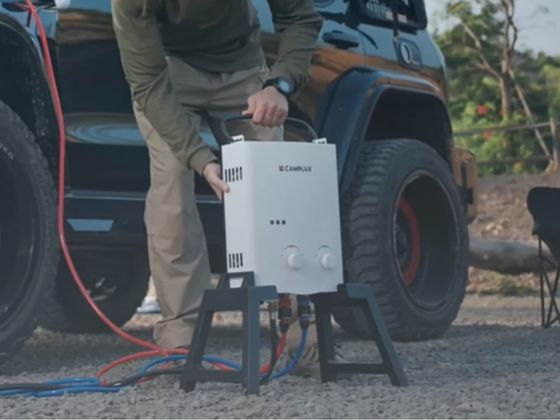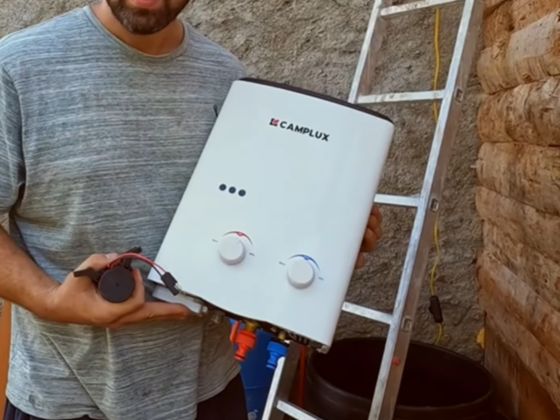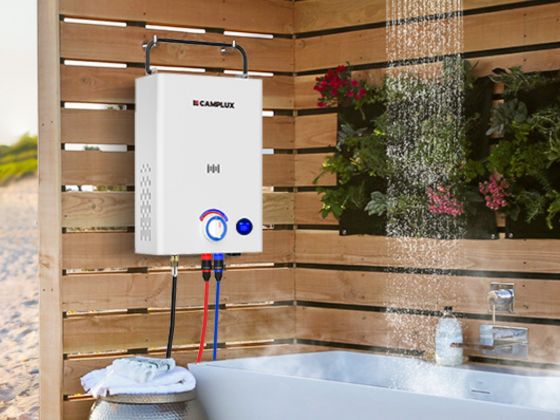TL;DR (the short of it)
-
On-demand LPG (Camplux BV series) heats water only when you open the tap, so there's no tank "standby" loss between showers.
-
Storage tanks keep water hot all day and night, which means daily energy losses even if no one showers.
-
Heat pumps are the lowest kWh option for full-time household use, but they're not portable and need a proper installation.
-
Your real-world running cost depends on how often you shower, your flow rate (L/min), and temperature rise (ΔT)—not just the badge on the unit.
How energy is measured (simple, no fuss)
-
Electricity: kilowatt-hours (kWh)
-
Gas/LPG: megajoules (MJ)
-
Quick conversion: 1 kWh = 3.6 MJ
Why this matters: when you compare products, they often quote different units. With the conversion above, you can bring them onto the same playing field.
What drives energy use:
-
Inlet temperature: Colder winter mains (say 10–15 °C) vs warmer summer mains (18–22 °C).
-
Target outlet temp: Many people shower around 40 °C.
-
Flow rate: e.g., 8 L/min on Camplux BV158.
-
Duration: 5 vs 10 minutes is literally double the hot water volume.
LPG 101 (for campers and shacks):
Common bottles are 4.5 kg and 9 kg. You only burn gas while the burner's on, so sporadic users avoid the penalty of keeping a big hot tank warm all day.
What we're comparing
-
Camplux portable/tankless outdoor LPG units — BV series (e.g., BV158, rated 8 L/min).
-
"Traditional" options Australians consider:
-
Electric storage (e.g., 50–250 L tanks)
-
Gas storage (mains gas or LPG cylinders)
-
Electric instantaneous (no tank, high electric draw)
-
Heat pump (air-source, very efficient for regular household use)
-
Solar-thermal with booster (extra context, not portable)
-
Note: Camplux BV units are outdoor-only and must be used with correct clearances and ventilation.
Method & assumptions (transparent and reproducible)
The heat you need to add is roughly:
Energy ≈ Volume × Specific heat × Temperature rise
For water: 4.186 kJ/kg·°C (handy number to remember)
Example test points (so you can sanity-check):
-
Outlet: 40 °C target
-
Inlet: winter 10–15 °C; summer 18–22 °C
-
Flow rates: 4 / 6 / 8 L/min
-
Durations: 5 and 10 minutes
Standby losses are included for storage tanks and not applicable for Camplux (no tank to keep hot). All Camplux use-cases here assume outdoor, ventilated, portable use—not a permanent indoor install.
Scenario A — One 5-minute shower (occasional use)
Let's take a typical comfortable shower:
-
Flow: 8 L/min (BV158)
-
Time: 5 minutes → 40 L of mixed water
-
ΔT (temperature rise): assume 25 °C (e.g., 15 °C mains to 40 °C outlet)
Heat required (in the water):
40 kg × 25 °C × 4.186 kJ/kg·°C ≈ 4.2 MJ (≈ 1.17 kWh)
Now, what different systems must consume to deliver that heat:
-
Camplux BV (LPG, on-demand): burner efficiency matters. If we ballpark at ~80% system efficiency, gas energy used ≈ 4.2 / 0.8 ≈ 5.2 MJ.
-
Electric instantaneous: typically near 100% efficient → about 1.17 kWh.
-
Heat pump: thanks to COP (coefficient of performance), electricity needed might be roughly 0.3–0.5 kWh for the same heat (COP 2.5–4).
-
Storage tanks: you'll still spend 1.17 kWh (electric) or the equivalent gas to heat the shower volume, plus whatever standby the tank already lost since the last use.
Why this matters for occasional users:
If you only shower once in a while, tankless on-demand avoids the "keeping-it-hot-just-in-case" cost. With a storage tank, you might be paying every day, regardless of whether anyone steps under the shower.
Scenario B — Weekend camping / vanlife (two people)
-
2 people × 2 showers/day × 2–3 days → 8–12 showers total
-
Using the same 5-minute, 8 L/min assumption and ΔT ≈ 25 °C, each shower is ≈ 4.2 MJ of water heat.
LPG usage with Camplux BV158 (illustrative):
At ≈ 5.2 MJ of gas per shower (including efficiency), 8–12 showers use ≈ 41.6–62.4 MJ.
A 9 kg LPG cylinder contains on the order of ~440 MJ of energy (rule-of-thumb), so your weekend will use around 9–14% of a bottle under these exact assumptions.
Reality check: colder inlets, longer showers, or higher flow rates will nudge that percentage up. Shorter, warmer, or thriftier use brings it down. The nice part is there's no standby between Friday night and Sunday morning—just turn the knob when you actually need hot water.
Scenario C — Off-grid cabin / shed (light weekly use)
Let's say the family visits a small cabin and takes 4–6 showers/week, with some dish-washing here and there.
-
Camplux BV: You burn LPG only during those showers/dish-wash sessions.
-
Electric options off a generator/solar-battery: You'll draw 1.17 kWh per 5-minute shower equivalent (more if longer/warmer), which can be a meaningful chunk of your stored battery or generator run time.
-
Heat pump: super-efficient for regular daily use, but off-grid the start-up draw, ambient temperature sensitivities, and installation complexity can be hurdles—fine for a permanent home, a bit much for a pop-up weekend shack.
Standby losses vs on-demand (the silent energy spender)
Storage tanks lose heat throughout the day. The exact number depends on tank size, insulation quality, and ambient temperature, but a ballpark daily standby for many electric storage tanks can be on the order of ~1–2 kWh/day (older or poorly insulated tanks can be higher; modern high-efficiency tanks can be lower).
For light users, those daily losses can outweigh the energy of the actual short shower. That's the whole on-demand story in a sentence: if you're not using hot water all the time, why keep a big tank hot all the time?
Running-cost comparison (plug in your own AU prices)
You can estimate per-shower cost quickly.
-
Figure the energy:
-
5-min, 8 L/min, ΔT 25 °C → ~4.2 MJ in water.
-
Electric instant: ~1.17 kWh.
-
LPG via Camplux BV: assume ~5.2 MJ gas purchased (allowing for efficiency).
-
Multiply by price:
-
Electricity tariff ($/kWh): varies by state/provider; plug in your bill rate.
-
LPG price: either $/kg or $ per 9 kg refill. Convert to $/MJ then multiply.
Illustrative only (you replace the numbers):
-
If electricity is $0.30/kWh, a 1.17 kWh electric-instant shower is ~$0.35.
-
If a 9 kg LPG bottle costs $35, and we assume ~440 MJ energy in that bottle, that's ~$0.08/MJ. A 5.2 MJ Camplux shower would be ~$0.42.
These two are in the same ballpark for the actual shower, but here's the kicker:
-
If a storage tank idles at 1–2 kWh/day of standby, that's $0.30–$0.60/day before anyone even turns on the tap. For occasional users, that background spend can dominate the bill.
Sensitivity notes:
-
Colder winter mains → bigger ΔT → more energy per shower.
-
Slower flow (e.g., 6 L/min instead of 8) → less water heated per minute → lower energy.
-
Shorter showers save on any system; fast on/off with tankless reduces waste while you lather.

Environmental angle (high level)
-
Emissions depend on the energy source: the grid's mix (coal/gas/renewables) for electric, and combustion for LPG.
-
Heat pumps usually win the household-wide efficiency race where hot water is used daily, thanks to COP.
-
On-demand can still be the lower-footprint choice for sporadic users, because it avoids idle losses entirely.
-
Water efficiency helps too: try lower flow rates or a "navy shower" routine (water off while soaping) to minimise waste without sacrificing comfort.
Practicalities beyond energy
-
Installation & compliance: Camplux BV units are outdoor-only. Keep correct clearances, ensure ventilation, and follow local regulations for LPG handling, hose routing, and mounting.
-
Maintenance: Fit an inline filter where water is hard/gritty, descale if needed, and drain down before frost.
-
Durability: Coastal salt, inland dust, and low water pressure are part of Australian life; keep inlets clean, shield from spray, and follow maintenance tips for longevity.
-
Start-up behaviour: Tankless units take a brief moment to spark and stabilise flame—perfectly normal. Once burning, hot water is continuous within the model's rated L/min.
Who should choose what? (decision guide)
-
Occasional/camping/van/seasonal shack: Camplux BV series (e.g., BV158, 8 L/min) is a great fit. You pay only when you actually want hot water.
-
Everyday family household with high daily demand: Heat pump (possibly with solar PV) often delivers the lowest ongoing cost in kWh terms—requires a proper install.
-
Small households with modest but regular use: A good electric instantaneous or efficient storage can make sense; compare tariffs and avoid over-sizing.
A quick mental check: If you're not home much, or your hot water use is burst-y (weekends away, job sites, sports days), don't feed a tank all week. If you shower like clockwork every day, a heat pump is hard to beat on kWh.
Camplux model match-ups (AU use cases)
-
Weekender & Vanlife: BV158 (8 L/min)—compact, simple, and ideal for one-person-at-a-time showers.
-
Family beach shack (light seasonal use): BV series with a tidy setup (stand + hose + filter) for easy pack-down at season's end.
-
Tradie / job-site rinse: BV series with robust hose/stand and filter—no fuss, no faff, quick cleanup.
Accessories to consider: inline filters, quick-connect hoses, mounting stands, and a winter drain kit for cold snaps.
Safety & compliance reminders (short but important)
-
Outdoor-only. Never operate a Camplux BV unit indoors or in enclosed spaces.
-
Keep clearances around the burner, maintain ventilation, and secure cylinders upright.
-
Check local regulations and follow the user manual closely.
-
Store cylinders out of direct sun and away from ignition sources.
FAQs (quick answers)
How many showers from a 9 kg LPG bottle?
It depends on flow, duration, and ΔT. Using the 5-min, 8 L/min, ΔT 25 °C example above (~5.2 MJ gas per shower), a ~440 MJ bottle could deliver roughly 80–85 showers. Colder winters and longer showers reduce that number; thriftier habits increase it.
Will a tankless unit work with low water pressure?
Camplux BV units have minimum pressure/flow requirements to ignite and stay running. If your supply is very low, consider a 12 V pump and follow the manual's specs.
What flow rate do I actually need?
For solo showers, many people find 6–8 L/min comfortable. Lower flows save water/energy; higher flows feel hotel-like but cost more to heat. BV158 at 8 L/min is a sweet spot for portable comfort.
Is a heat pump cheaper to run long-term than LPG?
For daily household use, often yes in kWh terms. But if you only need hot water sporadically or portably, the on-demand, no-standby profile of LPG tankless can win on overall cost and practicality.
Can I use a Camplux BV unit indoors?
No—outdoor-only. Always follow safety, clearance, and ventilation rules.
Summary & next steps
Energy consumption isn't just about the technology label; it's about how you use hot water.
-
If your pattern is occasional, portable, or seasonal, Camplux BV (e.g., BV158, 8 L/min) gives you hot water on demand with no standby loss.
-
If your home's hot water runs every single day, a heat pump (often with solar PV support) is likely your long-term kWh champion.
Ready to kit out your setup?
-
Explore Camplux BV series outdoor gas water heaters
-
Add filters, quick-connect hoses, and stands to make life easy
-
Check support & warranty for safe use across Australia
Use Australian spelling, metric units, and plug in your local tariffs/LPG prices to fine-tune the numbers. And if you want a simple calculator embedded in this page, say the word—I can sketch one out so your readers can punch in their own flow, time, ΔT, and local rates.

